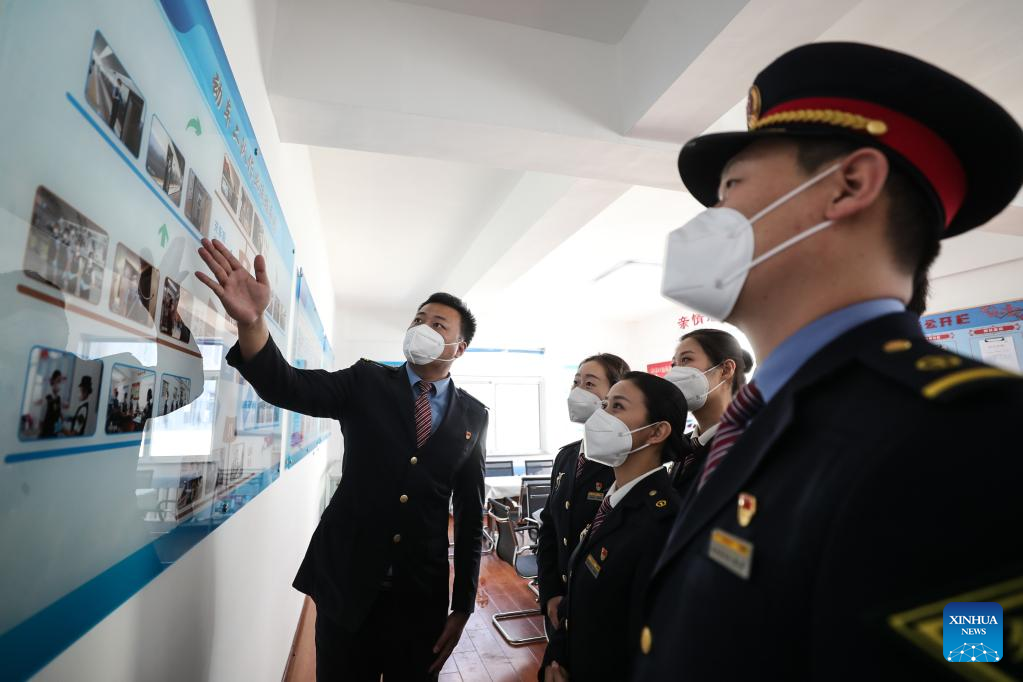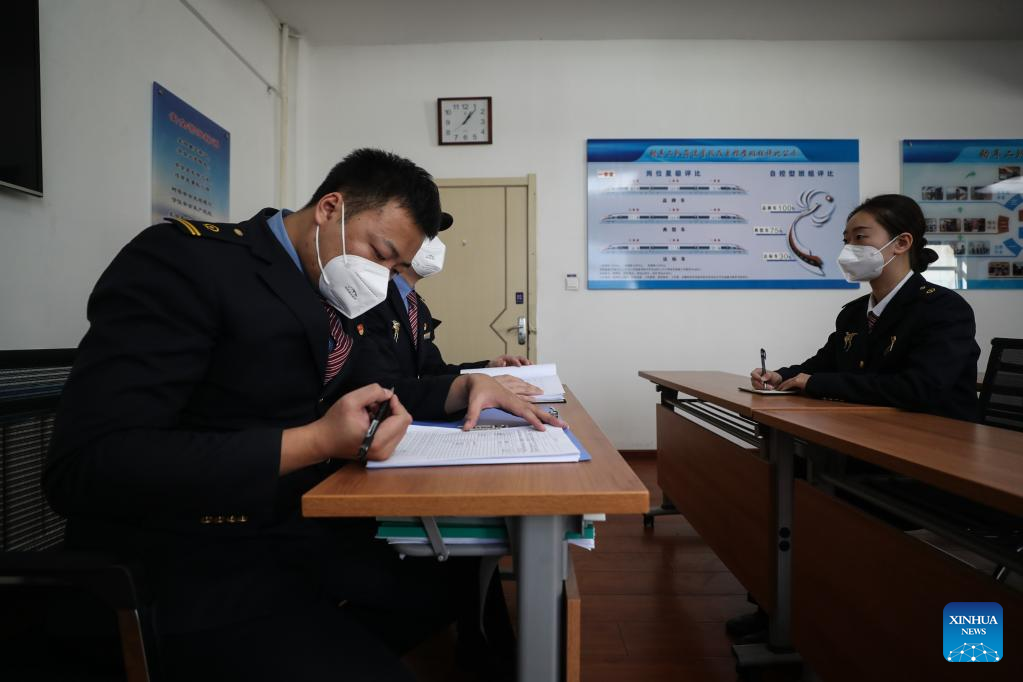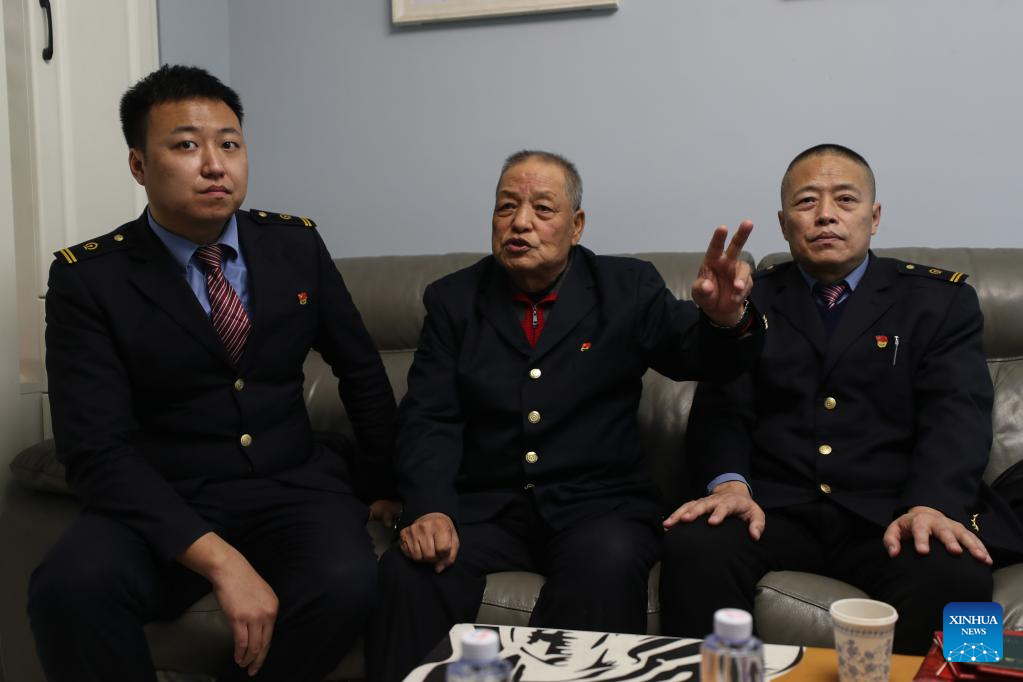
Deputy train conductor Zhao Peng (L) works with colleagues in Shenyang, northeast China's Liaoning Province, Oct. 18, 2022. (Xinhua/Pan Yulong)
SHENYANG, Jan. 20 (Xinhua) -- At 10:09 p.m., Wednesday, the G1225 high-speed train pulled in, slowly but imposingly, at Shenyangbei Railway Station in northeast China's Shenyang City, before stopping to allow an exodus of train passengers.
Not until the last passengers took their leave safely and soundly, did Zhao Peng, the deputy train conductor, finally call it a day.
Amid China's Spring Festival travel rush, also known as "Chunyun," numerous people braved bustling trains and other crowded vehicles to reach home and reunite with families, while millions of railway staff pulled out all the stops in order to ensure smooth and safe journeys.
Among them is Zhao, a 32-year-old staff member from China Railway Shenyang Group Co., Ltd. He started his work in 2012.
Zhao is the youngest generation of his family to build a career along the railway lines, following his great-grandfather, grandfather and parents.
"By coincidence, I became a railway staff member after I left the army. It must be fate," Zhao said, with a playful smile.
Decades on, the family has not only witnessed the development of China's railway but also become part of the railway history, rich with selfless dedication, ingenuity and enterprise.
With a maximum speed of more than 300 km per hour, the G1225 high-speed train was once unimaginable for predecessors like Zhao Peng's great-grandfather, who was among one of the earliest workers that made contributions to the railway development after the founding of New China in 1949.
"He got up early and walked through the pre-dawn gloom to work, mainly adding coal and other fuels to the locomotive engine which pulled dark carriages with wooden seats," recalled Zhao Zhenru, Zhao Peng's grandfather, a retired station master who started his career in 1960.
"He was always clad in overalls covered with coal ash and smelled like burning firewood," Zhao Zhenru recalled.
For Zhao Zeqiang, Zhao Peng's father, the most noticeable change in recent decades was the modernization of carriages.
Zhao Zeqiang began to work in 1985 and now is a train conductor for passenger railway management.
He still remembered the sleepless summer nights in carriages without air conditioners, where the temperature could hit some 40 degrees Celsius.
"We could only fall asleep while holding a large bulk of ice covered with a towel," he recalled. "When we woke up, we were amazed to find the towel was dry, like the bulky ice had never existed."
Since the 1990s, air-conditioned carriages have been introduced in China, starting to end the fear of intense heat and severe cold weather for both passengers and railway staff members.
From a train running around 40 km per hour in the 1950s to the Fuxing bullet train, independently developed by China, running with a speed of 350 km per hour, the four generations of Zhaos witnessed the country's efforts to upgrade transportation links and improve the well-being of people.
By the end of last year, the total operating length of China's railway network and high-speed railway network had exceeded 155,000 km and 40,000 km, respectively, according to data from China State Railway Group Co., Ltd.
"As one of the new generation of railway workers, I am determined to do a better job," said Zhao Peng, brimming with confidence that China's development will gain powerful momentum, like a roaring high-speed train. ■

Deputy train conductor Zhao Peng (L) and his colleagues prepare for work in Shenyang, northeast China's Liaoning Province, Oct. 18, 2022. (Xinhua/Pan Yulong)

Deputy train conductor Zhao Peng (L) poses for a photo with his grandfather Zhao Zhenru (C) and father Zhao Zeqiang in Shenyang, northeast China's Liaoning Province, Oct. 18, 2022. (Xinhua/Pan Yulong)



